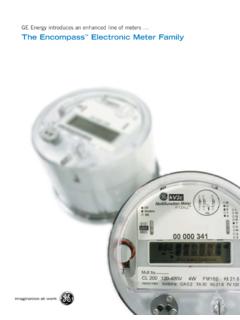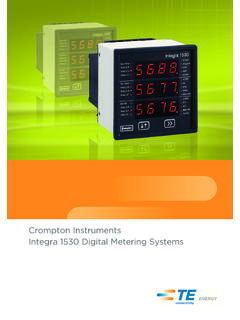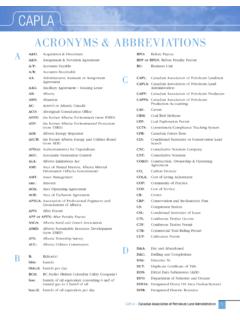Transcription of Ultra Low Power Boost Converter Charger Energy …
1 User's Guide SLUU654A October 2011 Revised October 2011. bq25504 EVM Ultra Low Power Boost Converter with Battery management for Energy Harvester Applications This user's guide describes the bq25504 evaluation module (EVM), how to perform a stand-alone evaluation and allows the EVM to interface with the system and host. This EVM is programmed from the factory for settings compatible with most MCU's and 3V coin cell batteries. The EVM is programmed to deliver a maximum voltage (OV) for charging the storage element and the under voltage is programmed to The VBAT_OK indicator toggles high when VSTOR ramps up to and toggles low when VSTOR ramps down to Contents 1 Introduction .. 2. EVM Features.
2 2. General Description .. 2. Design and Evaluation Considerations .. 3. 2 Performance Specification Summary .. 4. 3 Test Summary .. 4. Equipment .. 4. Equipment and EVM Setup .. 4. Test procedures .. 5. 4 PCB Layout Guideline .. 11. 5 Bill of Materials, Board Layout and Schematics .. 12. Bill of Materials .. 12. EVM Board Layout .. 13. EVM Schematic .. 15. List of Figures 1 Test Setup for HPA674A (bq25504 EVM) .. 5. 2 Startup with no Battery and 10k Load .. 6. 3 Startup with Battery Less Than UV .. 7. 4 Powering up with a Battery above UV .. 7. 5 BAT_OK High/Low Ramping Battery from 0V to (OV) and Down to .. 8. 6 Basic Switching Converter , Vin = 1V, Vbat = .. 9. 7 EVM Operation Near OV With 100- Battery Impedance.
3 10. 8 EVM PCB Top Assembly .. 13. 9 EVM PCB Top Layer .. 13. 10 EVM PCB Bottom Layer .. 14. 11 EVM Schematic .. 15. List of Tables 1 I/O Connections and Configuration for Evaluation of bq25504 4. 2 Bill of 12. SLUU654A October 2011 Revised October 2011 bq25504 EVM Ultra Low Power Boost Converter with Battery management for 1. Submit Documentation Feedback Energy Harvester Applications Copyright 2011, Texas Instruments Incorporated Introduction 1 Introduction EVM Features Evaluation module for bq25504. Ultra low Power Boost Converter / Charger with battery management for Energy harvester applications Resistor-programmable settings for under voltage, over voltage providing flexible battery management .
4 POTs Included for fine tuning the settings (not populated). Programmable push-pull output Indicator for battery status (VBAT_OK). Test points for key signals available for testing purpose easy probe hook-up. Jumpers available easy to change settings General Description The bq25504 is the first of a new family of intelligent integrated Energy harvesting Nano- Power management solutions that are well suited for meeting the special needs of Ultra low Power applications. The product is specifically designed to efficiently acquire and manage the microwatts ( W) to miliwatts (mW) of Power generated from a variety of DC sources like photovoltaic (solar) or thermal electric generators. The bq25504 is the first device of its kind to implement a highly efficient Boost Converter / Charger targeted toward products and systems, such as wireless sensor networks (WSN) which have stringent Power and operational demands.
5 The design of the bq25504 starts with a DC-DC Boost Converter / Charger that requires only microwatts of Power to begin operating. Once started, the Boost Converter / Charger can effectively extract Power from low voltage output harvesters such as thermoelectric generators (TEGs) or single / dual cell solar panels. The Boost Converter can be started with VIN as low as 330 mV typ., and once started, can continue to harvest Energy down to VIN 100 mV. The bq25504 also implements a programmable maximum Power point tracking (MPPT) sampling network to optimize the transfer of Power into the device. The MPP is listed by the harvesting manufacturer as a percentage of its open circuit (OC) voltage. Typically solar cells are at their MPP when loaded to ~80% of their OC voltage.
6 The bq25504 periodically samples the open circuit input voltage by disabling the Boost Converter (approximately every 16 seconds) and stores the programmed MPP ratio of the OC voltage on the external reference capacitor, C5. If the storage element is less than the maximum voltage (OV) then the Boost Converter will load the harvesting source until it reaches the MPP (C5 voltage reference) and then regulate the input voltage of the Converter , thus transferring the maximum amount of Power to the output. Alternatively, an external reference voltage can be provided, by a MCU to the REFS pin, to adjust C5 independently. The shunt on JP1 has to be moved from the Divider setting to STOR when providing this external reference (JP1-2 tied to JP1-1 OSC/STOR).
7 The bq25504 was designed with the flexibility to support a variety of Energy storage elements. The availability of the sources from which harvesters extract their Energy can often be sporadic or time-varying. Systems will typically need some type of Energy storage element, such as a re-chargeable battery, super capacitor, or conventional capacitor. The storage element will make certain constant Power is available when needed for the systems. The storage element also allows the system to handle any peak currents that can not directly come from the input source. To prevent damage to a customer's storage element, both maximum and minimum voltages are monitored against the user programmed under-voltage (UV) and over-voltage (OV) levels.
8 To further assist users in the strict management of their Energy budgets, the bq25504 toggles the battery good flag to signal the microprocessor when the voltage on an Energy storage element or capacitor has dropped below a pre-set critical level. This should trigger the shedding of load currents to prevent the system from entering an under voltage condition. The OV, UV and battery good thresholds are programmed independently. The EVM has three 500K . potentiometers (not installed at factory) to allow fine tuning of the three programmable thresholds. This only need be done if the user needs precision, the POTs provide about 50mV shift. For details, see bq25504 data sheet (SLUSAH0). 2 bq25504 EVM Ultra Low Power Boost Converter with Battery management for SLUU654A October 2011 Revised October 2011.
9 Energy Harvester Applications Submit Documentation Feedback Copyright 2011, Texas Instruments Incorporated Introduction Design and Evaluation Considerations This user's guide is not a replacement for the data sheet. Reading the data sheet first will help in understanding the operations and features of this IC. Be sure to make note of the capacitor selection section when designing the EVM. Many of the IC's pin names start with a "V" and this "V" is removed on the EVM connector's label. The names are interchangeable. This IC is a highly efficient Charger for a storage element such as a battery or super capacitor. In this document, battery will be used but one could substitute any appropriate storage element.
10 The main difference between a battery and a super capacitor is the capacity curve. The battery typically has little or no capacity below a certain voltage, where as the capacitor does have capacity at lower voltages. In the lab when using a lab Power supply rather than an Energy harvester, one will have the output of the lab supply, Vsource, followed by the harvester's impedance (about 20 ) and connected to VIN of the EVM. These two signals are separated by the 20 source impedance which represents the internal impedance of the source. VIN is equal to VSource when there is no load (open circuit) and is pulled down to the MPPT. harvester threshold when the Charger is able to deliver the maximum Power before reaching OV.












